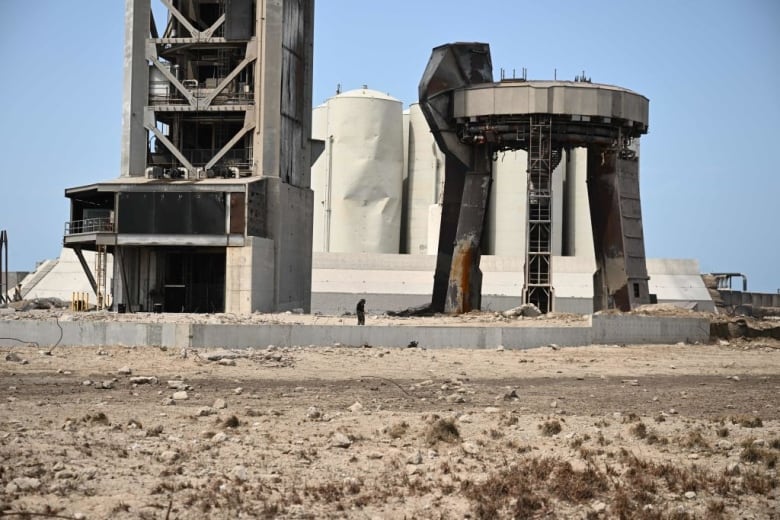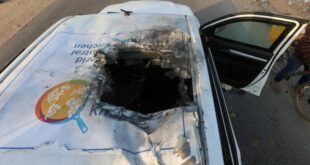The launch is scheduled for Friday at 8 a.m. ET.

After a spectacular end to its first test flight where it lost control and then exploded, SpaceX’s 36-storey rocket may see its second test flight on Friday.
The launch is scheduled for 8 a.m. ET with a two-hour window of opportunity.
Last April, the massive spaceship successfully launched from Boca Chica, Texas, but after veering out of control, was blown up over the Gulf of Mexico.
Many looked at it as a failure, and the Federal Aviation Authority ordered dozens of fixes before a second attempt. However, SpaceX hailed it as a success since they said their aim was to just have it clear the launch tower.
This time, SpaceX is going for Take 2, with the hope that this time the spaceship can complete its mission: reaching near orbital altitude before splashing into the ocean near Hawaii.
“I really believe it’ll go,” said space launch historian and former NASA illustrator Paul Fjeld. “I think they’ve been ready to fly probably for about a month.”
A 2nd integrated test of Starship
Starship is SpaceX’s super heavy launch vehicle. Founder Elon Musk has said many times that he believes the spacecraft will some day take humans to Mars.
It has two stages: the booster stage, called the Super Heavy, and the spaceship itself. Stacked together, they are called Starship, but the spaceship itself is also called Starship.
The Super Heavy has an impressive 33 engines, more than any rocket.

Starship the spaceship has only ever flown to 12.5 kilometres in altitude on its own. Of the four high-altitude test flights, only one has ever successfully landed.
This launch is often referred to as an “integrated test,” meaning Starship and the Super Heavy will be launching together as one vehicle.
What is the mission?
Those tests saw the spaceship return to SpaceX’s Starbase facility in Boca Chica, Texas. But the integrated test will be much different, and very interesting if all goes well.
First, the pair will launch together before the booster stage separates, the same way SpaceX’s Falcon 9 operates. If that goes well, the booster will perform a “boost back” where it flips and then returns to Earth, again, the same way the first stage of the Falcon 9 rockets do. However, in this case, it will be a “water landing” in the Gulf of Mexico, and will not be recovered.
At the same time, Starship will continue to ascend reaching near orbital altitude, before it re-enters the atmosphere, and also makes a water landing near Hawaii where it will sink to the bottom of the ocean.
The whole point of this mission is to test Starship’s systems to see how they perform in tandem.
Though Musk’s ultimate goal is to get to Mars some time in the next decade, in the nearer term, NASA is also counting on it for the Artemis III mission to the moon in 2025. SpaceX is providing the Human Landing system (HLS), a variation of Starship, to transport astronauts from lunar orbit to the surface of the moon itself.
What happened the first time?
Starship’s first integrated test flight definitely put on a show both in the sky and on the ground.
Once the engines ignited, it took a while to clear the launch pad. And when it did, it blew a crater several metres deep below it. It also sent boulders, rocks and dust for kilometres, which upset many nearby residents, some up to four kilometres away. There was also concern over the welfare of nearby wildlife.
As well, several engines failed, which may have been due to damage caused from the flying pieces of concrete.

As the rocket ascended, it began to flip uncontrollably, and the first stage didn’t separate. Rockets are equipped with flight termination systems for just such cases. However, it appeared that the ones on Starship failed to work. Eventually, the rocket exploded, four minutes after liftoff.
The fallout from the launch triggered an investigation by both Fish and Wildlife Services and the Federal Aviation Authority. In the meantime, SpaceX continued to work on several issues to improve both the launch pad and the rocket.
“They had that one launch … [where] they got a tremendous amount of data, I am sure,” Fjeld said.
The FAA required SpaceX to take 63 corrective actions and to apply for a modified licence before launching again.
What’s new this time?
SpaceX started working on the issues of concern immediately after the launch.
Among other changes, there have been modifications to the launch pad itself.
Most launch pads have a way of ensuring the rocket and the pad aren’t damaged due to the powerful forces — especially acoustic waves — that happen once the engines are fired (and remember, the Super Heavy has a whopping 33). Sometimes, it’s a water suppression system or a large trench that diverts the flames away.
The Starship launch pad had none of that, just a form of heavy-duty concrete called Fondag.
But since then, they’ve made some changes to the pad, reinforcing the foundation and including a water suppression system, which they tested with a static fire (meaning they light the engines without allowing the rocket to lift off) in October.
They also added another component to the rocket itself.
“The attempt we saw last time back in April, the Starship failed to separate from the Super Heavy booster,” said Jordan Bimms, a space historian and professor of science communication at the University of Chicago. “So now they are going to a hot staging method where the the upper stage Starship will ignite with the bottom stage still attached.”
That hot stage method helps boost performance, saving energy and time in an industry where both are incredibly valued.
“Musk is a fanatic about not losing performance where you don’t have to,” Fjeld said.
He’s optimistic about Friday’s prospects.
“I’m very excited to see it go. And I actually think that they’ve probably solved most of the problems,” he said. “I would be more surprised than not if they did not make it to near-orbit.”
As for Bimms, though he loves every rocket launch, he’ll be watching this second test cautiously.
“I want to be more excited than I really am, you know, because I do see this opening up more activity in space, which to me is exciting,” he said.
“But it’s like, who is holding the keys, who is directing this area of of technological innovation? It’s not somebody who I’m particularly excited about being in control of it.”
ABOUT THE AUTHOR

Senior reporter, science
Based in Toronto, Nicole covers all things science for CBC News. As an amateur astronomer, Nicole can be found looking up at the night sky appreciating the marvels of our universe. She is the editor of the Journal of the Royal Astronomical Society of Canada and the author of several books. In 2021, she won the Kavli Science Journalism Award from the American Association for the Advancement of Science for a Quirks and Quarks audio special on the history and future of Black people in science. You can send her story ideas at Nicole.Mortillaro@cbc.ca.
*****
Credit belongs to : www.cbc.ca
 Atin Ito First Filipino Community Newspaper in Ontario
Atin Ito First Filipino Community Newspaper in Ontario






